| 03-20-2016, 08:55 AM | #1 |
|
Private
 30
Rep 68
Posts |
CCB rotor wear ar 15k (pics)
I have just changed the front pads on my CCB'S (pads were at 50%) and today for the first time ive noticed some pitting on the wear indicators?
the car has done 15k miles, and 4 track days last year, but i wouldnt say i drive at 10 10ths on the track. I have had a look at some posts on ferrari and porsche forums that say this sort of wear on the indicators is nothing to worry about, but can anyone with experience of CCB's give their view? here are the wear indicators on the front rotors 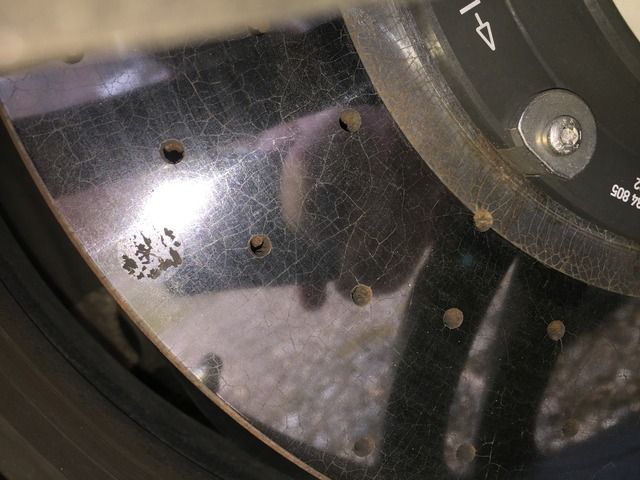 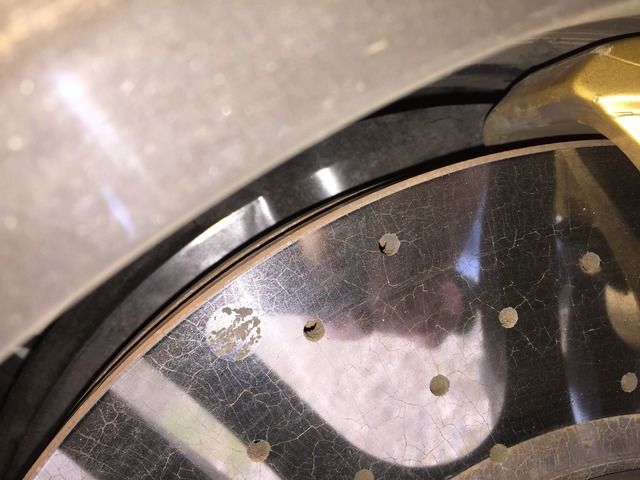 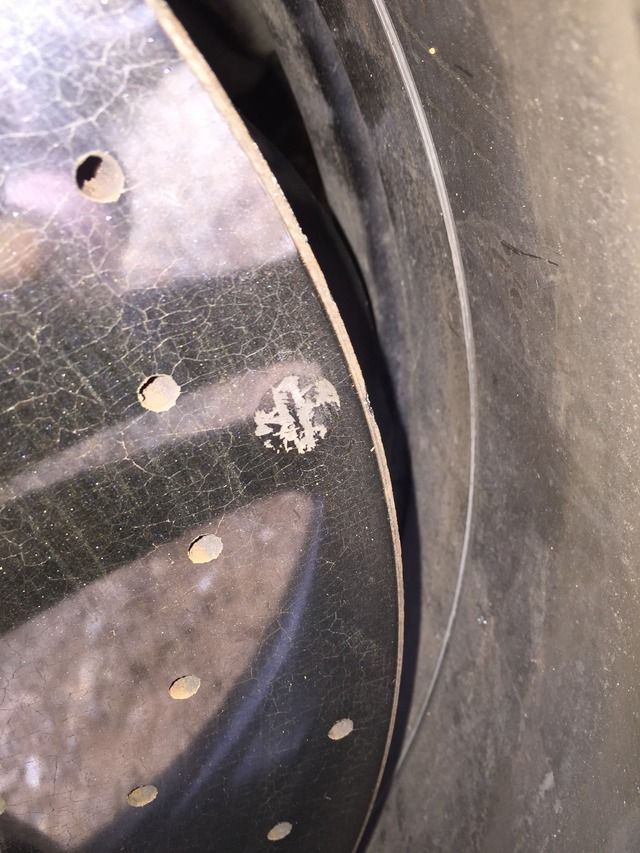 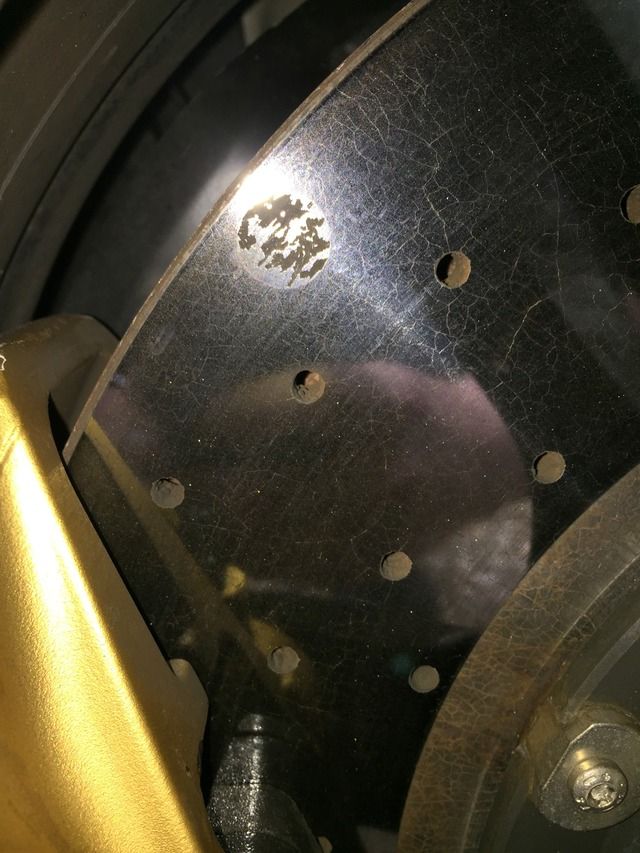 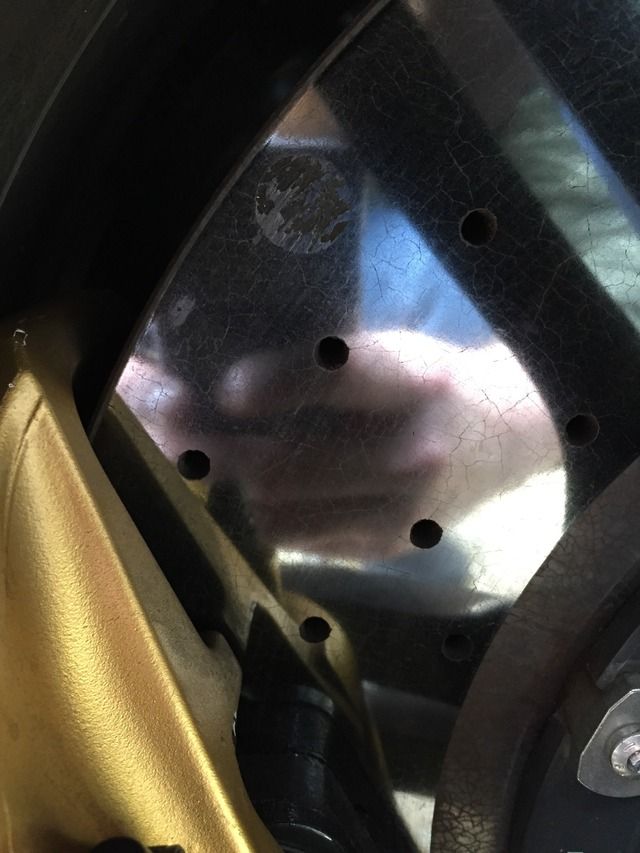 initially i thought that maybe the dealer had sent the wrong pads? and the pads were for irons not CCB, but i have checked the part numbers on the invoice and they are the correct numbers for CCB pads (plus i cant imagine they would fit if they were not CCB specific pads?) but they do look different to the oem pads slightly? 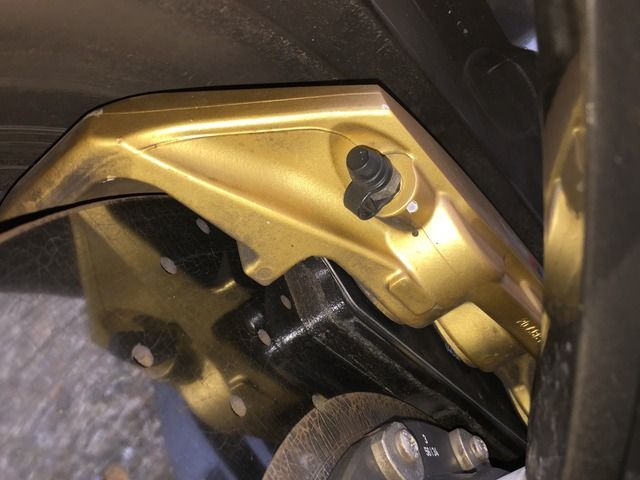  so yea, if anyone with CCB experience can shed any light on weather this is a normal wear rate or not, that would be great! thanks |
| 03-20-2016, 09:52 AM | #2 |
|
Lieutenant
   310
Rep 408
Posts |
I thought ccb rotors you have to weigh to get wear indication?
The carbon ceramic won't really get appreciably thinner like iron. But if the ccb gets too hot, the carbon oxidizes (ie burns) and this reduces weight of the ccb rotor. It reduces the strength of the rotor and once too much carbon burns the rotor becomes fragile and will physically break during use. |
|
Appreciate
0
|
| 03-20-2016, 09:55 AM | #3 | |
|
Private
 30
Rep 68
Posts |
Quote:
but the small circles pictured on the disc are the "wear indicators" i think when they completely pit they indicate the rotor needs changing |
|
|
Appreciate
0
|
| 03-20-2016, 10:18 AM | #4 | |
|
General
    
21117
Rep 20,741
Posts
Drives: 2021 911 turbo
Join Date: Jan 2012
Location: Montreal
|
Quote:
See the .pdf in this sticky thread.
__________________
Porsche 911 turbo 2021 992 GT Silver
 Previous cars: M4cs 2019 F82 Limerock Grey / M4 2015 F82 Silverstone / M3 2008 E92 Silverstone / M3 2002 E46 Carbon Black |
|
|
Appreciate
0
|
| 03-20-2016, 10:19 AM | #5 |
|
General
    
21117
Rep 20,741
Posts
Drives: 2021 911 turbo
Join Date: Jan 2012
Location: Montreal
|
Rotors need to be replaced when the wear indicators are >50% pitted.
__________________
Porsche 911 turbo 2021 992 GT Silver
 Previous cars: M4cs 2019 F82 Limerock Grey / M4 2015 F82 Silverstone / M3 2008 E92 Silverstone / M3 2002 E46 Carbon Black |
|
Appreciate
1
|
| 03-20-2016, 11:00 AM | #6 |
|
Private
 30
Rep 68
Posts |
|
|
Appreciate
0
|
| 03-20-2016, 11:50 AM | #7 |
|
Private
 30
Rep 68
Posts |
am i right in thinking that it wouldnt be possible for BMW to send the wrong pads?
is there a set of non CCB pads that would fit these calipers? just seems weird how they have worn so fast, the indicators have only just deteriorated to this |
|
Appreciate
0
|
| 03-20-2016, 01:37 PM | #8 | |
|
General
    
21117
Rep 20,741
Posts
Drives: 2021 911 turbo
Join Date: Jan 2012
Location: Montreal
|
Quote:
 ? Would those fit? ? Would those fit?
__________________
Porsche 911 turbo 2021 992 GT Silver
 Previous cars: M4cs 2019 F82 Limerock Grey / M4 2015 F82 Silverstone / M3 2008 E92 Silverstone / M3 2002 E46 Carbon Black |
|
|
Appreciate
0
|
| 03-20-2016, 02:52 PM | #10 |
|
Private
 30
Rep 68
Posts |
It's well known with CCB's that running pads bellow 50% can cause rotor damage, due to hitting the metal pins in the pad, and something to do with heat dissipation. Things that aren't really an issue with iron discs
|
|
Appreciate
3
|
| 03-20-2016, 02:54 PM | #11 |
|
Private
 30
Rep 68
Posts |
Yea that's a point, I think they would, the invoice did have the correct part numbers, I could remove a pad to check, but hey have only been on for about 40 miles? So not sure if they would cause this much accelerated wear in that time?
|
|
Appreciate
0
|
| 03-20-2016, 02:56 PM | #12 |
|
Private
 30
Rep 68
Posts |
Could be just down to the track days? On a plus side, the Sicom disc refurbishment is around £1600, which isn't bad at all, better than £11,000 I was quoted for replacements at the dealership!
|
|
Appreciate
0
|
| 03-20-2016, 03:27 PM | #13 |
|
General
    
21117
Rep 20,741
Posts
Drives: 2021 911 turbo
Join Date: Jan 2012
Location: Montreal
|
CCB rotors wear very fast with higher temperatures due to the oxidation of the fibers inside the matrix, hence why they have a minimum weight limit. Changing pads at 30~50% wear reduces the amount of heat transferred to the rotors during track use and helps prolong rotor life. No need to replace that early on street driven only car.
From the Brake Deep Dive and Interview:
__________________
Porsche 911 turbo 2021 992 GT Silver
 Previous cars: M4cs 2019 F82 Limerock Grey / M4 2015 F82 Silverstone / M3 2008 E92 Silverstone / M3 2002 E46 Carbon Black Last edited by CanAutM3; 04-12-2016 at 03:52 PM.. |
|
Appreciate
3
|
| 03-20-2016, 06:09 PM | #15 | |
|
Lieutenant
   
98
Rep 469
Posts |
Quote:
|
|
|
Appreciate
0
|
| 03-21-2016, 09:36 AM | #17 | |
|
Captain
    
1026
Rep 842
Posts |
I concur that the wear you're seeing is the discs oxidizing, and it is most likely due to the track use. We see this constantly on Corvette (C7 Z06), Camaro, Porsche (991 GT3), Ferrari 458, etc. We've had customers destroy their CCM/CCB discs in as little as 8-10 days on the track. About ten years ago, I was able to destroy a set of CCM discs on my Z06 in a single afternoon at Buttonwillow. Despite what the OEM vehicle manufacturers claim, carbon ceramic discs are currently NOT the best choice for track use. When carbon ceramic discs get too hot, they oxidize. Period, end of story. People argue with us until they're blue in the face, but we see it over and over again.
Below is some info from our website: In the past few years, Carbon Ceramic brake discs have become increasingly popular on high-end sports cars as either standard equipment or as a factory installed option. Although expensive, they're a great choice for a car that is used exclusively on the street. They save a large amount of unsprung weight, they don't generate much brake dust, have low NVH, and they may even last longer than the rest of the car! For the avid track enthusiast however, they're typically not the best choice. On the racetrack however, repetitive stops from high speeds generate considerably higher brake disc temperatures vs. what could ever be legally or sanely achieved on the street. Various manufacturers producing the current crop of carbon ceramic discs claim to match iron disc durability on the track, but our experience tells us otherwise. While they may be less resistant to warping or deformation at repeated elevated temperatures, the biggest problem with carbon ceramic discs is that they tend to oxidize at track temperatures, showing rough surface eruptions on the disc face. In some cases the oxidation is terminal (chopped fiber discs), and the discs must be scrapped once it occurs. In other cases (continuous fiber discs), the discs can be resurfaced, but only a limited number of times and at a high cost. Most carbon ceramic discs are measured in terms of minimum mass, rather than the traditional minimum thickness used to measure iron discs. Once the minimum mass is reached, the carbon ceramic disc is trash. Below is an oxidized carbon ceramic disc from a C7 Z06. The pictured damage was sustained across roughly 8-10 track days. Notice the dark spots in which the surface is flaking off / eroding. When your disc looks like this, it has become a $2,000 paperweight!  Other Potential Pitfalls with Carbon Ceramic Discs Low airflow- If you look at a specific car model that offers both iron and carbon ceramic discs as an option, the carbon ceramic discs will almost always be considerably larger in overall dimension, with a specific emphasis on a tall radial depth (distance from outer disc edge to inner disc edge). Whereas an iron disc uses a web of directional internal vanes to speed airflow through the disc, most carbon ceramic discs rely on their large surface area to radiate heat into the air surrounding the disc. Hence, the tall radial depth. Expensive and limited range of compatible brake pads- There aren't many brake pad options with carbon ceramic discs. The pads must be compatible with the specific disc material being used, and if they aren't, they can destroy the discs in a hurry. Since brake pads are a very personal choice to most track junkies, carbon ceramic discs don't provide many options for the driver to chase a desired feel. Also as noted above, carbon ceramic discs tend to be very tall radially, which means very large brake pads are required. In the world of brake pads, price is usually directly proportional to size: Bigger = more expensive. Poor feel- Experienced drivers will tell you that cast iron discs provide superior pedal feel due to less compress-ability. Some drivers find that carbon ceramic discs feel soft or abrasive at lower temperatures, but feel like stone with little modulation once they heat up. Feel and the resulting confidence is rather important when hurtling towards a guardrail at 150mph! High replacement disc cost- Carbon ceramic replacement discs can be hideously expensive. If you do wear out or damage a disc, it can cost thousands of dollars to replace each one. When running carbon ceramic discs hard on a racetrack, the odds of having to replace one or more of them increases exponentially vs. if you only drive your car on the street. Damage-prone- Many manufactures suggest covering their carbon ceramic discs when handling them, so they are not chipped or fractured. One knock when changing a wheel can destroy a disc. Additionally, some chemical wheel cleaners or abrasives used in car detailing can damage carbon ceramic discs. Splinters- Carbon ceramic discs shouldn't be handled with bare hands, as they can leave carbon splinters in the skin. Greater sensitivity to burnishing/bedding-in- Most manufacturers have an explicit, and sometimes intricate, set of instructions for bedding-in their carbon ceramic discs. Iron discs can typically be prepared via a simple series of stops from 60-80 mph with the brake pad of choice. Carbon Ceramic is NOT Carbon/Carbon At this stage you may be saying to yourself, "But I saw that the XYZ professional race cars were running carbon brakes at the track." The carbon brakes currently being used in professional racing are carbon/carbon (abbreviated C/C), which is actually a different material vs. the carbon ceramic discs used on road cars. The carbon ceramic brake discs on road cars are a Carbon Ceramic Matrix (CCM). In recent times many professional racing series (F1, ALMS, IRL, etc.) have switched to carbon/carbon brake discs in an effort to reduce weight. Carbon/Carbon is an outstanding lightweight material for racing, but requires heat before it starts to generate usable friction. As such, they're completely ill-suited to a typical morning commute in a road car! When we post the above information, CCM/CCB owners inevitably come out of the woodwork defending the technology. They've invested a large sum of money, so they want to be correct, which is understandable. They tell us we don't know what we're talking about, that BMW, Porsche, or Chevy would never offer CCB's on their halos car if it wasn't the best option for track use, etc. However, the next week we always see another owner post pics of his destroyed discs after he tracks his car repeatedly. Again, CCM/CCB discs are a wonderful option for road use. When they are operated at high temperatures however, they can and will oxidize. Iron discs are still the best choice for heavy track use. They offer an array of benefits: Increased airflow- A quality iron racing disc with a high vane count promotes airflow, heat evacuation, and rapid cooling. They don't rely on a large surface area to cool via radiation. The iron discs will move more air than a carbon ceramic disc, and as a result they won't heat your brake pads, caliper pistons, and brake fluid up as quickly. You'll be able to run longer sessions without brake fade, and you'll enjoy the confidence that comes along with them. They'll also make any brake ducts that you have on the car more effective and useful. Huge range of compatible brake pad compounds- Iron discs will open up a much greater range of available brake pads. You'll be able to achieve a different feel, and tailor your brake setup depending on your needs and environment, whether that is running an AutoX or the most demanding racetrack in your area. You'll also likely be paying less per brake pad set than you were previously, and your pads will last longer. Inexpensive spare discs- You'll no longer have to spend thousands of dollars when it's time to replace your discs. Iron disc rings typically only cost $300-500 each, so you won't have to stress about anything happening to them. They're inexpensive enough that you can always keep a spare set on hand, so you won't have to worry about any brake-related downtime when you're out at the track. Durability- Iron discs can take a beating. You can stash your spares in your race trailer, and you won't have to worry about handling them, covering them, dinging them, or chipping them when changing your wheels. Most of all, they don't oxidize. They will eventually crack, but typically last far longer than a carbon ceramic under heavy track use. Quote:
Horsepower Curb weight Tire size and compound Track layout Driver experience Length of session Aero Brake ducts etc. A relatively novice driver at Willow Springs may get 25 track days out of his CCB discs on his unmodified M4 on OEM tires. On the other hand, a gutted M4 with a larger turbo, on slicks, driven by a pro at Road America might only get 6 days before they oxidize. Again, there a huge number of variables, and it's more or less impossible to make a blanket statement about how long a set of CCB's should last. Our recommendation remains...if you plan to track your car, the best iron racing brake systems will offer superior performance and huge cost savings vs. a CCB system. Our Essex Designed AP Racing Radi-CAL Competition BBK is the perfect example. It even gives you some of the weight savings that the CCB's offer, but spare costs are a fraction of the CCB setup. They're a great investment, because when you pull them off the car and sell them used, you can still recoup 60+% of the purchase price. When you burn up a set of OEM CCB discs, they are pretty much worthless on the used market. If you do have the CCB system with gold calipers, and you want to track your car consistently, our advice is to shelve the OEM CCB brake system until you sell your car on the used market. Replace them with an iron system designed explicitly for track use. Due to their extremely high replacement cost, the CCB discs will be one of the very first points on the car that any serious buyer considering your car is going to examine. If you don't believe us, look at any 'for sale' ad for a high-end Porsche 911 with CCB's. The first question potential buyers ask is the condition of the discs. If the discs show wear/oxidation, it will have a severe negative impact on your selling price. Nobody wants to buy a used car and then have to immediately shell out $10k for new brake discs. Carbon ceramic brake technology has evolved quite a bit over the past decade, and continues to march forward. That said, it still can't quite match the performance and cost of a proper iron racing system for track use. To the OP...if you decide to stick with the CCB's and plan to keep tracking your car, get some good brake ducts to try and bring the operating temps down on the discs. Short of that and the frequent pad changes, there's not a whole lot you can do to slow their oxidation. What you will see next on your discs is that other areas of the disc face will start to look like the wear indicator windows. Eventually the disc will start to look like the pic I posted above. Hopefully this was helpful, and let us know if we can help you stop throwing money at the CCB's. Thanks.  |
|
|
Appreciate
16
BitchinManWheels343.50 infamousdiz603.00 lpshikhar150.50 M3 Pilot73.50 MrMGrey18.50 qmp123.50 stormlv932.00 AustinGelbM4196.00 |
| 03-21-2016, 10:36 AM | #19 | |
|
Law Enforcer

25063
Rep 22,282
Posts
Drives: '22 Chalk Gray Porsche C2S
Join Date: Jun 2006
Location: ..in your rearview!!!
|
Quote:
|
|
|
Appreciate
1
|
| 03-21-2016, 12:11 PM | #20 | |
|
Private
 30
Rep 68
Posts |
Quote:
Ah well, I guess it's either irons that fit the CCB calipers or get the fronts refurbished. Weird too, no sign of any wear on the backs at all. Even pads have loads of meat left. Is the rate of the front wear alarming to you guys at all? For 4 track days and 15k? Or can they really go that fast? Although thinking about it, the track I go to, has two big straights that you need to brake hard at 130+ down to 60 for, and another 2 pretty hard braking zones down from 80-90 to 29-30mph, and the track is short, only 3 miles, so I'd imagine as tracks go, that's pretty hard on the brakes Lesson learnt though! I wont be choosing CCB in future? Out of interest could you let me know how much your radical brake uptake would be for the M4? I did see them a few weeks back. They look awesome! Last edited by MTW1989; 03-21-2016 at 12:19 PM.. |
|
|
Appreciate
0
|
| 03-22-2016, 03:19 PM | #21 | ||||
|
Captain
    
1026
Rep 842
Posts |
Quote:
As I mentioned in my last post, in most cases there are just too many variables to definitively predict if you and your car, on your track, with your mods are going to destroy the brakes in one session or fourteen sessions. As such, you need to be a good boy scout and "be prepared."  That means your brake components must be up to snuff for any trip to the searing brake temps the track produces...one time, or a hundred times...it doesn't matter. If they aren't, you're gambling with their destruction. That means your brake components must be up to snuff for any trip to the searing brake temps the track produces...one time, or a hundred times...it doesn't matter. If they aren't, you're gambling with their destruction.Quote:
Swapping out your CCB's for their iron equivalent would basically be like installing 22" chrome wheels. Quote:
Keep in mind that later this year we'll be releasing a matching rear Pro5000R complete BBK. On something like a Porsche 911, the rear engine/RWD drivetrain layout dictates that the car will use relatively more brake compared to something like an M3 or Corvette. The weight shift going into a brake zone is much different with all that weight behind the rear axle. The wear/abuse on the front and rear are more balanced on the Porsche, whereas on the M3/M4, the fronts take the brunt of the beating. Quote:
 You can see all the details/price on our site. We have two options. The CP9660/372mm takes a more standard 18mm thick pad and fits behind OEM M4 wheels without a spacer. The CP9668/372mm uses a 25mm thick pad and requires a spacer. You can see all the details/price on our site. We have two options. The CP9660/372mm takes a more standard 18mm thick pad and fits behind OEM M4 wheels without a spacer. The CP9668/372mm uses a 25mm thick pad and requires a spacer. |
||||
|
Appreciate
0
|
| 03-27-2016, 10:36 AM | #22 | |
|
Lieutenant
   
98
Rep 469
Posts |
Quote:
|
|
|
Appreciate
0
|
Post Reply |
| Bookmarks |
|
|